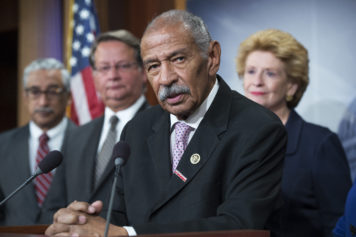Considering the brutal, nasty racial history of the state of Mississippi, it’s probably the last place most people would expect to be the location of the nation’s first state-funded civil rights museum.
But on Thursday, state officials and civil rights leaders will be on hand to break ground on a plot of land in Jackson, near the state fairgrounds and Capitol building, that eventually will be the site of the Mississippi Civil Rights Museum.
It’s being built alongside a new state history museum that’s being erected on the same site, with both scheduled to open in 2017—in time for the state’s bicentennial. The two museums will be connected to one another by a common entryway and they will share resources, in addition to classroom space and an auditorium.
“This is going to make a powerful statement I think, not only to the state but to the country,” William Winter, a Democrat and governor from 1980 to 1984, told Al Jazeera America. “That in Mississippi, we now understand the importance of the participation of both races of Black folks and white folks working together, to build a state, and out of that come the mutual respect and understanding of our common humanity at the same time that we understand the differences of the history that go into our respective backgrounds.”
“I think it’s appropriate, I think it’s the right thing to do and I think this is the right place to do it,” he said. Winter is the founder of The William Winter Institute for Racial Reconciliation and a champion for improved race relations in his state.
The funding of the civil rights museum was one of its biggest challenges, according to Democratic Mississippi state Sen. John Horhn, who served on the state commission that helped pass the legislation to create the museum.
“I’ve not had in my 21 years being in the [state] Senate an experience where 10 different conference reports were drawn up for presentation to the Senate that were not brought to the floor,” he said. “It was the 11th time that was the charm.”
Mississippi, of course, was the locus of some of the most painful episodes of the civil rights era, such as the assassination of Medgar Evers in June 1963 and the murders of three civil rights workers a year later. The deaths led to an investigation the FBI called “Mississippi Burning,” which was immortalized by Hollywood with a movie of the same name.
With a pricetag of close to $90 million in the poorest state in the country, the museum hopes to help Mississippi join the growing boom of heritage tourism and to attract visitors from around the world.
“It’s going to mean thousands of people coming to the city, and it’s going to mean thousands of people coming to the state and this museum,” said Robert Luckett, a professor of African-American and civil rights history at Jackson State University.
“We look at our sister institutions in Birmingham and in Memphis and we know people are going to these places and visiting them and making them significant tourist attractions,” he said. “So it also has a real economic significance.”
“As a historian and a professor at an HBCU (historically Black college or university), it amazes me how little my students know about their own history and their own culture, but also how much they want to learn about their history and culture,” Luckett continued. “I have students whose parents and grandparents were civil rights activists and they don’t know it because they don’t talk about it and they haven’t asked.”
It’s a well-known fact that museums dedicated to African-American history usually have challenges raising enough funds to keep the doors open. The fledgling National Slavery Museum in Fredericksburg, Va., had to file for bankruptcy after failing to raise enough private funding to pay for construction and property taxes, while The International Civil Rights Center & Museum in Greensboro, N.C., built on the site of the 1960 sit-in movement, has had epic financial struggles since it opened in 2010; it has run close to a $400,000 deficit each year and has defaulted on a $4 million loan.
But the Mississippi project will be different because its funding will come straight from the state—though it will still need some outside help.
“We know that we will have to continue to supplement that endowment with private funds, and we hope that once we are open and we have our public programming established, and see that we are valued in the community, the community actually uses us and wants to be a part of what we do in this institution, that we’ll have private funders who will want to continue to fund these types of programs and operations of it,” Lucy Allen, director of the 2 Mississippi Museums project, told Al Jazeera.
“It can’t depend upon revenue from the gate, from admissions,” said John Fleming, a consultant for the Mississippi Civil Rights Museum and a former president of the Association of African American Museums. “If you’re constantly having to raise revenue, then you are detracting from the true mission that you have and that is to bring about change in society. One thing that I pointed out was that the African-American community needs to step up to the plate and support these institutions, just like they historically have supported the African-American church.”
Jacqueline Dace, curator and project manager for the civil rights museum, said one of its biggest challenges will be getting artifacts from skeptical collectors.
“You have to show up and prove yourself,” Dace told Al Jazeera. “We may have to wait until after the museum is open before we begin to receive those artifacts we’re seeking because the trust has to be built. There have been several decades of a trust being broken down, and now the trust has to be built.”
Dace, who says she is currently on the hunt for a hand-painted sign from the March on Washington, knows she will be spending many days on the road, convincing people to donate items to the museum instead of auctioning them off or selling on eBay.
Dace said that she often hears people say, “They’re not going to tell the story, they’re not going to tell it in the detail it needs to be told, or they’re not going to tell the truth.”
But, she said, “That’s what I came for. I wouldn’t be here if it wasn’t the concept that we’re going to tell it in all its ugly, graphic detail.”
“If Mississippi can do it, anyone can do it,” Horhn said.


